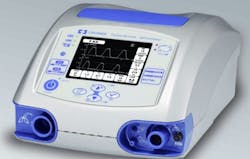New Open-Source Ventilator Design Joins the War on COVID-19
Renesas Electronics is in the final stages of its open-source ventilator system reference design, announced by the company on April 16, and expects to be putting boards based on the design into production in mid-June. The reference design was created to enable manufacturers to quickly produce ready-to-assemble boards for portable medical ventilators intended for use in hallways or non-ICU use cases.
Although it doesn’t have the extended functionality of advanced ventilators that can sustain ICU patients for weeks at a time, the lower-cost unit is capable (and safe) enough to free up many of the scarcer full-function units to be used where they’re most needed.
DK Singh, Director of Renesas' Systems and Solutions Team, said that, during the design process, their engineers closely followed several open-source ventilator designs, including the Medtronic PB560, to come up with an easy to assemble three-board ventilator design. The electronics control the blower, which creates the tidal volume, the mixture of gas delivered to the patient, and monitors the patient’s status.
The ventilator is designed to be very portable and can be used with or without gas tanks. In addition, a humidifier can be connected to the ventilator’s intake path to soothe the patient’s breathing, making it more comfortable to be connected for long durations.
The reference design uses 20 Renesas ICs, consisting of microcontroller (MCU), power, and analog ICs that address many of the ventilator’s signal-chain electrical functions. The system design implements a sensor board, a motor-control board, and features Bluetooth connectivity that allows medical professionals to monitor several patients simultaneously via a tablet or other mobile device. Each board has a MCU to control its specific task while monitoring the status of the connecting board. The ventilator solution also provides a system of checks and balances to enable regulatory approval and provide patient safety.
The design is based on the specifications of standard electronic boards; thus, they don't require any special materials, handling, or assembly practices. Therefore, any assembly house currently manufacturing industrial electronics should be able to produce them. Renesas says that it has identified a couple of different vendors to supply the blower, valves, and other non-electronic elements of their prototype, but the end user would be free to use and adapt for any other vendors.
Mr. Singh said that the design files will be available soon, after fine tuning and final testing is complete. In the interim, Renesas has published an architecture to help interested parties engage with the company on redesigning the board at their end. He stressed that they will provide all of the design files and guidelines to facilitate redesign—they’re not selling these boards and customers will have to design and reproduce these boards at their facility. For more information, visit Renesas ventilator system reference design.
About the Author
Lee Goldberg
Contributing Editor
Lee Goldberg is a self-identified “Recovering Engineer,” Maker/Hacker, Green-Tech Maven, Aviator, Gadfly, and Geek Dad. He spent the first 18 years of his career helping design microprocessors, embedded systems, renewable energy applications, and the occasional interplanetary spacecraft. After trading his ‘scope and soldering iron for a keyboard and a second career as a tech journalist, he’s spent the next two decades at several print and online engineering publications.
Lee’s current focus is power electronics, especially the technologies involved with energy efficiency, energy management, and renewable energy. This dovetails with his coverage of sustainable technologies and various environmental and social issues within the engineering community that he began in 1996. Lee also covers 3D printers, open-source hardware, and other Maker/Hacker technologies.
Lee holds a BSEE in Electrical Engineering from Thomas Edison College, and participated in a colloquium on technology, society, and the environment at Goddard College’s Institute for Social Ecology. His book, “Green Electronics/Green Bottom Line - A Commonsense Guide To Environmentally Responsible Engineering and Management,” was published by Newnes Press.
Lee, his wife Catherine, and his daughter Anwyn currently reside in the outskirts of Princeton N.J., where they masquerade as a typical suburban family.
Lee also writes the regular PowerBites series.



